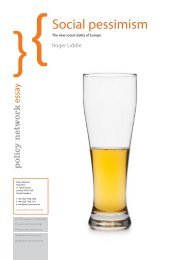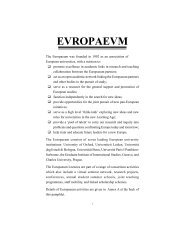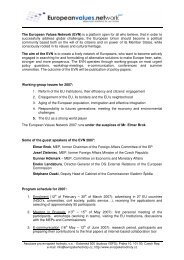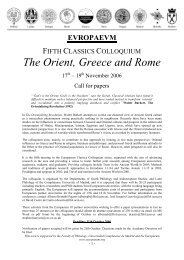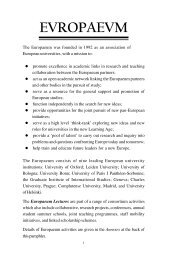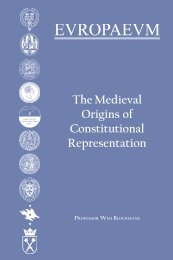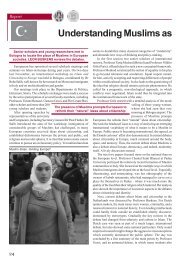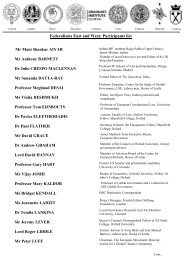Authors Iain Begg | Gabriel Glöckler | Anke Hassel ... - The Europaeum
Authors Iain Begg | Gabriel Glöckler | Anke Hassel ... - The Europaeum
Authors Iain Begg | Gabriel Glöckler | Anke Hassel ... - The Europaeum
You also want an ePaper? Increase the reach of your titles
YUMPU automatically turns print PDFs into web optimized ePapers that Google loves.
actors happens through hierarchical and market mechanisms, while in<br />
Coordinated Market Economies (CMEs, e.g. Germany) coordination<br />
happens primarily through non-market mechanisms, which include, for<br />
example, relational or incomplete contracting, networks cooperation, and<br />
monitoring. LMEs and CMEs are two stylised configurations in which the<br />
highest degree of coherence between different institutions such as the<br />
labour market, the financial sector, and corporate law, is reached. As a<br />
consequence, firm relations and corporate strategies vary systematically<br />
across these ideal types of capitalism. In the real world, most countries<br />
are situated in the space between these two archetypes, clustering around<br />
one or the other.<br />
An important corollary of this theory is that seemingly distinct spheres of<br />
the economy, such as for example labour law and financial regulation, are<br />
closely connected. Under ideal conditions, there will be a high degree of<br />
complementarity between these spheres. For example, if investors have<br />
access to information about the internal operation of firms, thus basing<br />
their decisions on networking, reputation and long-term relations, their<br />
decisions are likely to be less influenced by short-term performance<br />
and profitability. A “patient” model of corporate finance allows firms to<br />
support expensive vocational training programmes for their employees,<br />
which in turn increases productivity levels. A highly specialised workforce<br />
is likely to generate incremental, small-scale innovation on processes<br />
and products. <strong>The</strong> protection of employees against dismissals, under<br />
this framework, complements the other institutions because long-term<br />
relations with employees reduce the chances that other firms poach a<br />
well-trained worker. In other words, in CMEs, employment protection<br />
legislation is not a source of rigidity generating higher-than-optimal wage<br />
levels. On the contrary, it becomes a way to insure the investment in<br />
human capital undertaken by firms.<br />
If investors do not have access to information networks, as is the case<br />
in LMEs, firm financing will happen primarily through the stock market.<br />
Balance sheets and short-term performances will drive investor decisions<br />
and a fluid labour market will allow employment to follow capital<br />
allocation. Firms will tend not to provide vocational training, and the state<br />
will have a lesser role in vocational training and education. Employees<br />
will tend to develop general skills, more widely adaptable, rather than<br />
industry-specific skills, which prevail in CMEs. This logic of institutional<br />
complementarities is confirmed by empirical observations. Data show that<br />
countries with a comparatively higher value of stock market capitalisation,<br />
such as for example Denmark, and the United Kingdom, have more<br />
Chapter 8 – Dermot Hodson and Marco Simoni 117



